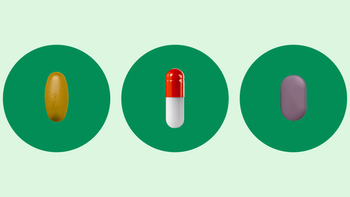
What Does Prednisone Do, and How Long Does it Take to Work? Plus, 9 More Pharmacist Tips
Key takeaways:
Prednisone (Prednisone Intensol) is an oral corticosteroid medication. It treats several inflammatory, autoimmune, and allergic health conditions.
Prednisone starts working a few hours after you take it. But it may take a couple of days before you experience its effects.
Common prednisone side effects include elevated blood glucose (sugar) levels, upset stomach, and trouble sleeping. More serious side effects are also possible, but they’re more likely to happen with long-term use. Taking prednisone in the morning with food or milk helps lessen certain side effects.
Prednisone is available as a lower-cost generic. You can find it for as low as $7.20 at certain pharmacies with a free GoodRx discount.
Access savings on related medications
Table of contents
When you’re given a prescription for prednisone (Prednisone Intensol), you’re likely looking for relief from symptoms caused by an overactive immune system. These symptoms can be painful, uncomfortable, or sometimes even scary. Finding quick relief is a top goal in these situations.
If you or your child just started taking prednisone, you may wonder when it might start to kick in. Other common questions — such as if you should take it with food or milk — are also helpful to know about.
Whether you’re prescribed a short- or long-term course of prednisone, you'll want to make sure you know how to take it and what to expect.
Search and compare options
What does prednisone do?
Prednisone is an oral corticosteroid (“steroid”) medication. It helps reduce swelling by mimicking a natural hormone in your body called cortisol.
Because of how prednisone works, it’s often used to treat autoimmune, allergic, and inflammatory health conditions. It’s approved to treat conditions such as:
Skin rashes
Rheumatoid arthritis (RA)
Allergies, including seasonal allergies and allergic reactions
Adrenal insufficiency (when your body doesn't have enough natural cortisol)
Prednisone is also prescribed off label for many health conditions. Chronic obstructive pulmonary disease (COPD) exacerbations, heart inflammation, and hepatitis are common examples.
10 pharmacist tips for taking prednisone
Corticosteroids such as prednisone are generally well-tolerated when taken as directed. Here are some quick tips to help maximize the benefits of your prednisone prescription.
1. Prednisone starts working relatively quickly
For most people, prednisone starts working a few hours after your first dose. But that doesn’t mean you’ll always see noticeable effects right away. Depending on why your healthcare provider prescribed prednisone, you might not notice any benefits until a couple of days after you start taking it.
What’s more, a delayed-release (DR) version of prednisone is also available. It’s called Rayos. By design, Rayos takes longer to start working than standard versions of prednisone. It starts to kick in after about 4 hours. This delay can be beneficial in certain situations. For example, when it’s taken at night, it can help relieve pain and stiffness from RA that’s more intense in the morning hours.
2. Prednisone doesn’t stay in your system for very long
Prednisone typically stays in your system for less than 1 day.
After you take a dose of prednisone, your body starts to break it down and get rid of it. The time it takes for half of your original dose to leave your body is called the half-life. The half-life can be used to predict how long the medication will stay in your system.
After about 4 to 5 half-lives, a medication is considered “cleared” from the body. For adults, prednisone’s half-life is around 3 to 4 hours. This means it can stay in your system for up to 20 hours. For children, the half-life is 1 to 2 hours, so it can stay in their system for up to 10 hours.
3. Different prednisone doses are available
There’s not a standard definition of what “high dose” prednisone is. Many experts consider it to be any dose above 40 mg per day. A low dose of prednisone is considered to be less than 7.5 mg per day. Any dose in between, such as prednisone 20 mg, is considered moderate.
4. Some people take prednisone for longer than others
There’s not a set time frame for how long you’ll take prednisone. You may take prednisone for anywhere from a few days to many years. This depends on why prednisone is prescribed.
In general, higher doses and longer treatment courses come with an increased chance of side effects. These are discussed in detail later on.
5. Try to avoid drinking alcohol while taking prednisone
Alcohol doesn’t change how prednisone works, but it’s best to avoid or reduce drinking while you’re taking it.
This is mostly because of side effects. Alcohol and prednisone both weaken your immune system. Your risk of infection goes up when they’re in your body at the same time. The pairing can also impact your mood and sleep quality and contribute to heartburn or stomach ulcers.
Your healthcare provider is the best resource to help you decide when to safely add adult beverages back into your routine.
6. Side effects are less likely when you take prednisone with food
It’s a good idea to take prednisone with a meal or snack. When starting a prednisone prescription, your pharmacist may tell you to take it with food or milk. This helps prevent an upset stomach, which is a common side effect that people report while taking prednisone.
7. Try to avoid combining prednisone and Advil
Use caution about taking prednisone with nonsteroidal anti-inflammatory drugs (NSAIDs), such as ibuprofen (Advil, Motrin), naproxen (Aleve, Naprosyn), and aspirin (Bayer Aspirin, Bufferin, and others). Taking NSAIDs and prednisone together may potentially raise your risk of developing stomach ulcers.
Out of caution, talk with your healthcare provider before taking an over-the-counter NSAID while taking prednisone. They can also tell you about other drug interactions that you may want to keep in mind.
8. Take prednisone soon after you wake up
Prednisone can cause you to feel awake and activated. It’s usually better to take prednisone in the morning because of this. Taking it closer to bedtime will likely keep you up at night.
Once you have established a prednisone routine, consistency is key. Try to take your dose at the same time, the same way, every time. This helps build a healthy habit and makes it less likely that you’ll miss a dose.
9. Don’t worry about one or two missed doses
If you miss or forget a dose of prednisone, there’s no need to panic. Just take your dose as soon as you remember. But if it’s close to the time of your next scheduled dose, you should skip the dose you missed altogether. You should not take a “catch-up” dose, nor take two doses at once.
However, if you were prescribed a short-term course of prednisone in a blister pack (dose pack), these instructions may differ. Your healthcare provider may ask you to take multiple tablets at a time if you receive the medication late in the day or you accidentally miss a dose. Make sure to defer to their instructions.
If you miss multiple doses, your prednisone prescription may not work as well. And in rare cases, missing more than a few days of prednisone can lead to steroid withdrawal. This resembles adrenal insufficiency, causing symptoms such as fatigue and weakness. It can happen if your body has grown accustomed to receiving prednisone.
Good to know: People taking steroid prescriptions long term are more likely to experience steroid withdrawal than people who take them for just a few days.
10. There are a number of prednisone side effects to keep in mind
As with all medications, prednisone has some side effects to be aware of. Here are some common side effects to watch out for and some tips for managing them.
High blood glucose
Your blood glucose (sugar) levels may go up while taking prednisone, even if your blood glucose was previously under control.
This risk is especially relevant for people living with diabetes. While you’re taking prednisone, try to check your blood glucose more often. This will help make sure you stay informed if your blood glucose levels don’t stay within range.
High blood pressure
There’s a chance your blood pressure could go up while taking prednisone. This is because of the natural role that cortisol plays in your body.
If you’ve been told that you have high blood pressure, your healthcare provider may want you to check your blood pressure more often while you’re taking prednisone. If your blood pressure reading jumps to 180/120 mmHg or higher, don’t ignore it — even if you don’t have any noticeable symptoms. Contact your healthcare provider right away or seek emergency treatment.
Insomnia or difficulty sleeping
As mentioned earlier, prednisone has an activating effect. It can cause trouble sleeping. This is especially true if it’s taken too close to bedtime. For this reason, it's usually recommended to take prednisone in the morning, unless your healthcare provider recommends otherwise.
Weight gain and fluid retention
Steroids such as prednisone can raise your appetite. A larger appetite will cause some people to gain weight while taking prednisone, especially if it’s taken long term. Steroids can also cause our bodies to hold on to fluid. Holding on to more fluid is another reason you might notice weight gain.
There are a few strategies to help prevent this:
Exercise regularly.
Avoid high-fat foods or foods that are high in sugar.
Avoid or minimize alcohol intake.
Take prednisone only for a short period of time.
Wear compression socks.
Stomach discomfort
Stomach discomfort is another common prednisone side effect. As mentioned, taking prednisone with food or milk may help prevent an upset stomach. Stomach discomfort is more likely to happen if you take prednisone on an empty stomach.
More severe side effects
They’re rare, but prednisone can also cause more severe side effects. These side effects are more often seen in people who take prednisone for a long time. Potential risks include:
Higher risk of infection
Heart disease
Kidney injury
If you experience signs or symptoms of any of these conditions, reach out to your healthcare provider right away.
How to save money on your prednisone prescription
Prednisone is available as an oral tablet and oral solution (liquid). Both the tablets and solution are available as generic versions that are relatively affordable.
You can find 30 tablets of generic prednisone 20 mg for as low as $7.20 at certain pharmacies with a free GoodRx coupon. An equivalent amount of prednisone oral liquid can cost as low as $77.15.
What’s more, if you have commercial insurance, you may be eligible to pay as little as $0 for brand-name Rayos using a savings card from the manufacturer.
The bottom line
Prednisone is a corticosteroid medication that’s FDA-approved for many inflammatory, autoimmune, and allergic health conditions. Prednisone should start to work within a few hours, but it may be a couple days before you see its full effects. It’s best to take it in the morning with food or milk to lessen side effects.
The most common side effects of prednisone include elevated blood glucose, upset stomach, and trouble sleeping. Weight gain is also possible. More severe side effects include a higher risk of infection, weakening of bones, and eye problems. Severe side effects are more likely with long-term use. It’s recommended to talk to your healthcare provider about the risks and benefits of prednisone before taking it.
Why trust our experts?



References
Akalestou, E., et al. (2020). Glucocorticoid metabolism in obesity and following weight loss. Frontiers in Endocrinology.
American Osteopathic College of Dermatology. (n.d.). Steroids (oral).
ANI Pharmaceuticals, Inc. (2023). Prednisone- prednisone tablet [package insert].
Bryant Ranch Prepack. (2023). Prednisone- prednisone tablet [package insert].
Ferrari, P. (2003). Cortisol and the renal handling of electrolytes: Role in glucocorticoid-induced hypertension and bone disease. Best Practice & Research Clinical Endocrinology & Metabolism.
Gensler, L. S. (2013). Glucocorticoids. The Neurohospitalist.
Hodgens, A., et al. (2023). Corticosteroids. StatPearls.
Horizon Therapeutics USA, Inc. (2021). Rayos - prednisone tablet, delayed release [package insert].
Hunter, R. W., et al. (2014). Glucocorticoids and renal Na+ transport: Implications for hypertension and salt sensitivity. The Journal of Physiology.
Joseph, R. M., et al. (2016). Systemic glucocorticoid therapy and adrenal insufficiency in adults: A systematic review. Seminars in Arthritis and Rheumatism.
Liu, D., et al. (2013). A practical guide to the monitoring and management of the complications of systemic corticosteroid therapy. Allergy, Asthma & Clinical Immunology.
MedlinePlus. (2020). Prednisone.
Narum, S., et al. (2014). Corticosteroids and risk of gastrointestinal bleeding: A systematic review and meta-analysis. BMJ Open.
Pincus, T., et al. (2011). Long-term prednisone in doses of less than 5 mg/day for treatment of rheumatoid arthritis: Personal experience over 25 years. Paediatric Rheumatology.
Puckett, Y., et al. (2023). Prednisone. StatPearls.
Ramamoorthy, S., et al. (2016). Corticosteroids-mechanisms of action in health and disease. Rheumatic Disease Clinics of North America.
Was this page helpful?
Related Articles
Browse medications
View AllResearch prescriptions and over-the-counter medications from A to Z, compare drug prices, and start saving.

























